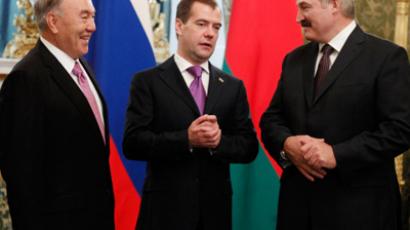Eurasian 'One For All'
After nearly two decades of big plans and little action, the Eurasian Economic Community (EurAsEC) looks like it may finally become reality, with member countries hoping the union will help to create a market able to resist the financial crisis.
The Presidents of Russia, Kazakhstan and Belarus signed a Declaration of Intent in Moscow on Friday that could see EurAsEC become fully operational within five years.An EU-style bond between former Soviet republics that became independent after the collapse of the USSR in 1991 has been touted for nearly two decades. In recent years the pace of integration has picked up. Since July the three countries have become members of a Customs Union – paying no tariffs when trading with each other. And from January they will be part of a common economic space – meaning workers and companies will be able to move freely between the member states. The measures are intended to raise trade, and give companies a greater choice of labour and location.“In order to compete globally in industry and technology we need to pool the resources of our countries,” said Russia’s Minister of Economic Development Elvira Nabiulina.The EurAsEC will have until 2013 to draw up the next steps in integration. These could include the introduction of common administrative bodies, and measures to harmonise economic legislation between the member states, making it easier for companies to move production and goods across the area. The Community could also welcome other post-Soviet states, with Kyrgyzstan – which is already set to join the customs union – considered the likeliest newcomer.The politicians behind EurAsEC have boasted that since the introduction of the customs union trade between member countries has already increased by as much as 40%.A potential problem could be the countries’ very varied external trade policies. Once Russia, Belarus and Kazakhstan begin to operate as a single market, these will be unsustainable. Russia, which is set to join the World Trade Organisation next year, has called for other countries to adopt the free-trade principles of that organisation. It also says it will support Kazakhstan and Belarus in their bids to join the WTO, but the latter at least looks unlikely to be given entry any time soon."There's a big question mark how it happens in practice? For instance, if goods come from Belarus to Russia, and then exported to Europe, will the country of origin be marked as Belarus? There're many technical details to be worked out," says Chris Weafer, chief strategist from Trokia Dialog.Another potential pitfall is the political aspect of the union. Talk of political integration has threatened to overshadow the economic implications of EurAsEC – and while some politicians have said the ideal is to become at least as close as the European Union – an organisation that has its own parliament and President – others have rejected the idea as an unwelcome return to Soviet times. In any case, EurAsEC is only just being realised in practice, and much of its future will depend on what results it delivers in the coming years.Says Professor Alexander Libman of the Frankfurt School of Finance & Management: “If the union opens itself up to the world, it will promote ties and fruitful co-operation. If it chooses the path of ‘Fortress Eurasia’, its economic development will be severely diminished.”













